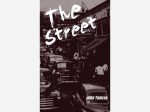
I have always loved John Yamrus’s minimalist approach to poetry, so it came as no surprise to me that I love his minimalist approach to memoir in his latest book, The Street. The Street is ostensibly about the street where Yamrus grew up and his childhood years, but it encompasses much more than that. In a postmodern and often meta approach to storytelling, Yamrus shows us what it was to live in a blue collar coal town in the Northeast, which might have been any working class town anywhere in America, while at the same time obliquely discussing the nature of memory and consciousness, what it means to perceive through the limited lens of ourselves. Also, because he is approaching his memoir through flash fiction vignettes rather than an overarching narrative, he creates a memory of a place more than of an event or series of events. In that, he is able to focus on what it was like for him to inhabit a small Pennsylvanian town in the 1950s and 1960s, what that culture and time was for the people who lived there. Because of this approach, it is a memoir of the street he lived on as much as it is a memoir of his childhood, as the title of the book suggests.
The Street as a memoir of place rather than events explores all of those people, ways of life, and traditions that have passed on. This memoir, however, is not cheap nostalgia. He remembers the place with both love and bitterness. A largely Catholic community, he remembers the aggression and unkindness of religious people and leaders. The priests in his community are interested in controlling others, and the nuns are often angry. Religion is about dividing people. When he asks about why he is supposed to hate people of other religions, a nun depicts Hindus, and by extension all non-Catholics as unfeeling to the point of evil:
they don’t value life the way we do . . . in their religion, they think that whatever happens is god’s will and there just no changing it and if they’re doing something like riding in a boat and someone falls overboard, they’ll just sit there and watch while that person drown right in front of them, even if it’s their own son or daughter or mother or father (77-78).
This is the kind of stereotyping and lies that he is given every day, and soon he learns to hate Jesus and the people who preach about him. That is not to say that this is a memoir rooted in bitterness; he simply does not remember everything as being perfect, and of course, no place is perfect. What he remembers with love are the people on his street. These were coal miners who cared for each other and died young because of the difficulties of their profession. He remembers how loving they were to each other and to him as well.
The Street, however, is more than just a discussion of his life; he also discusses the nature of consciousness and memory, and how the rememberer constructs meaning. Early on in the book, he breaks into a scene to self-consciously discuss this idea:
This memoir is going to be difficult to keep straight . . . for the reader as well as the writer . . . because memories aren’t linear (anyone who’s read Proust knows that) . . . memories are like leaves on a tree . . . and they fall at different times, at different speeds, in different ways . . . eventually, no matter how they fall, they end up covering the ground (30).
Throughout, he discusses not only what he remembers but also how he remembers it. He knows that his father was imperfect, as any person is; however, his father died at the age of 45, which was when Yamrus was young, so his memories are tinged with longing, regret, and hero worship: “he’d step out of that coal truck and it was like god coming down from heaven. the door would swing open and he’d step out, real slow, like a gunslinger . . . like Gary Cooper in High Noon” (27). This way of remembering the people and places of his past adds a level of realism to it. Rather than trying to find a kind of objective truth, he lets his truths be subjective when they need to be. The realism comes through his subjectivity because we all view the world in this way, through the lens of our own memory and consciousness. He comes back to this approach over and over until we understand that he’s talking about the nature of memory, his and ours.
I think that Yamrus’s The Street is my favorite book by Yamrus, and that’s saying a good deal because I have always loved his approach. I did not grow up in a small coal mining town in Pennsylvania, but I felt at home in his world. He remembers his world as we all remember ours with the emotions that well up when we look back.
John Brantingham 28th January 2024









